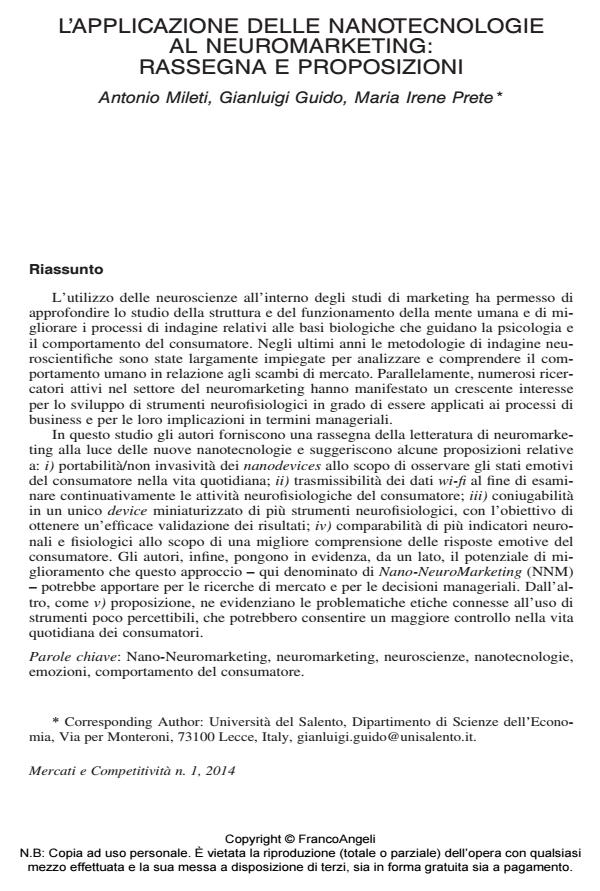L’applicazione delle nanotecnologie al neuromarketing: rassegna e proposizioni
Titolo Rivista MERCATI E COMPETITIVITÀ
Autori/Curatori Antonio Mileti, Gianluigi Guido, Maria Irene Prete
Anno di pubblicazione 2014 Fascicolo 2014/1
Lingua Italiano Numero pagine 19 P. 17-35 Dimensione file 571 KB
DOI 10.3280/MC2014-001002
Il DOI è il codice a barre della proprietà intellettuale: per saperne di più
clicca qui
Qui sotto puoi vedere in anteprima la prima pagina di questo articolo.
Se questo articolo ti interessa, lo puoi acquistare (e scaricare in formato pdf) seguendo le facili indicazioni per acquistare il download credit. Acquista Download Credits per scaricare questo Articolo in formato PDF

FrancoAngeli è membro della Publishers International Linking Association, Inc (PILA)associazione indipendente e non profit per facilitare (attraverso i servizi tecnologici implementati da CrossRef.org) l’accesso degli studiosi ai contenuti digitali nelle pubblicazioni professionali e scientifiche
L’utilizzo delle neuroscienze all’interno degli studi di marketing ha permesso di approfondire lo studio della struttura e del funzionamento della mente umana e di migliorare i processi di indagine relativi alle basi biologiche che guidano la psicologia e il comportamento del consumatore. Negli ultimi anni le metodologie di indagine neuroscientifiche sono state largamente impiegate per analizzare e comprendere il comportamento umano in relazione agli scambi di mercato. Parallelamente, numerosi ricercatori attivi nel settore del neuromarketing hanno manifestato un crescente interesse per lo sviluppo di strumenti neurofisiologici in grado di essere applicati ai processi di business e per le loro implicazioni in termini manageriali. In questo studio gli autori forniscono una rassegna della letteratura di neuromarketing alla luce delle nuove nanotecnologie e suggeriscono alcune proposizioni relative a: i) portabilità/non invasività dei nanodevices allo scopo di osservare gli stati emotivi del consumatore nella vita quotidiana; ii) trasmissibilità dei dati wi-fi al fine di esaminare continuativamente le attività neurofisiologiche del consumatore; iii) coniugabilità in un unico device miniaturizzato di più strumenti neurofisiologici, con l’obiettivo di ottenere un’efficace validazione dei risultati; iv) comparabilità di più indicatori neuronali e fisiologici allo scopo di una migliore comprensione delle risposte emotive del consumatore. Gli autori, infine, pongono in evidenza, da un lato, il potenziale di miglioramento che questo approccio - qui denominato di Nano-NeuroMarketing (NNM) - potrebbe apportare per le ricerche di mercato e per le decisioni manageriali. Dall’altro, come v) proposizione, ne evidenziano le problematiche etiche connesse all’uso di strumenti poco percettibili, che potrebbero consentire un maggiore controllo nella vita quotidiana dei consumatori.
Parole chiave:Nano-Neuromarketing, neuromarketing, neuroscienze, nanotecnologie, emozioni, comportamento del consumatore.
Antonio Mileti, Gianluigi Guido, Maria Irene Prete, L’applicazione delle nanotecnologie al neuromarketing: rassegna e proposizioni in "MERCATI E COMPETITIVITÀ" 1/2014, pp 17-35, DOI: 10.3280/MC2014-001002